How does an artist make a residency studio feel like home?
Emerging Ghanaian artist Adjei Tawiah spent six weeks working in a Brooklyn studio away from his base in Accra as he prepared for “I miss you», the artist’s first major solo exhibition in the United States, currently on view at the Opera Gallery in New York.
Over the past few years, Tawiah has been noted as an important emerging artist to watch. In 2021, Amoako Boafo chose Adjei for Magazine T‘s”Artists on Artists to Watch» and he was recently selected by Kehinde Wiley for the collective exhibition «Self-addressed” at Jeffrey Deitch.
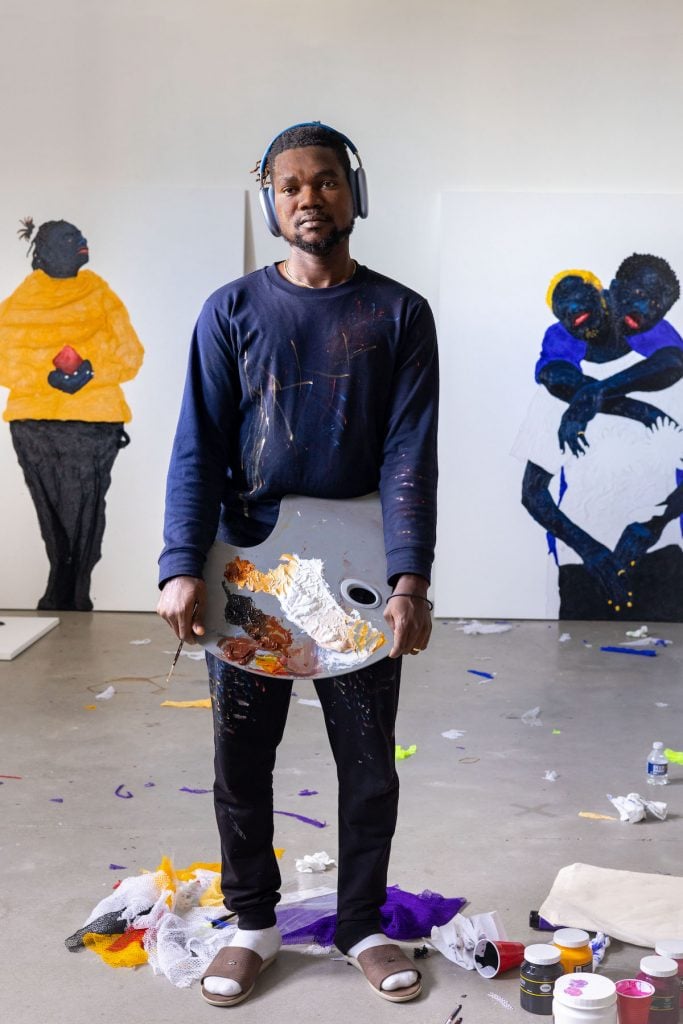
Adjei Tawiah in his Brooklyn studio, 2023. Courtesy of the artist and the Opera Gallery.
“I Miss Us” features the latest from Tawiah portraits, a group of tender paintings that explore the emotions that linger long after a relationship has ended. The lovers are depicted gently holding each other. The characters in the individual portraits cast distant glances, in an atmosphere of melancholy haunted by memory. Painted with Tawiah’s recognizably pulsating intensity and marked by vivid hues, the paintings are vibrant and nostalgic. In these compositions, tawiah incorporates kotsa, a nylon terry material popular in Ghana. Typically used for bathing and in funerary traditions, kotsa incorporates the idea of ablution into the works themselves.
To finalize these works, the artist used his Brooklyn studio as a place of meditation and concentration, but also as a home. where he plays his favorite music and dines on Ghanaian dishes as Waakye and Kontomire Stew.
Recently, he invited us to this bright space in Brooklyn, where we got a glimpse of the artist’s creative process.
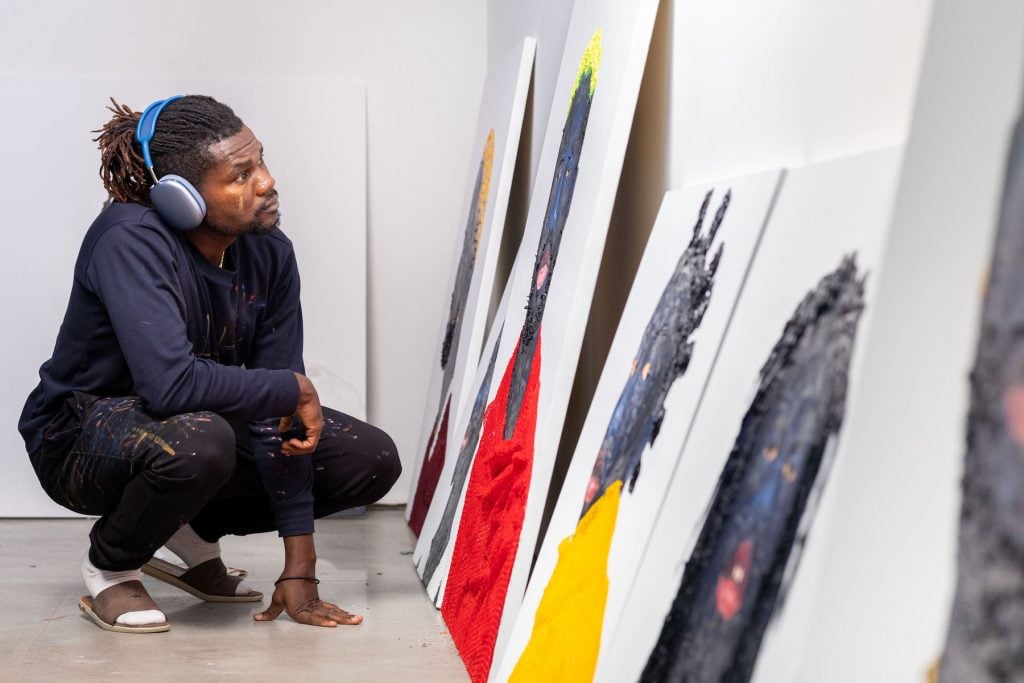
Adjei Tawiah in his Brooklyn studio, 2023. Courtesy of the artist and the Opera Gallery.
Tell us about your studio. Where is it, how did you find it, what type of space is it?
My studio is in Brooklyn on Bergen Street. I spent about six weeks here in a residency leading up to my first solo exhibition in New York at the Opera Gallery on the Upper East Side. The studio is located on the fourth floor of the building, which means that I do my daily training before painting. I learned to love climbing these stairs every day. The space is really big, much bigger than my studio in Accra, Ghana, where I come from.
Do you have studio assistants or other team members working with you? What are they doing?
Back in Ghana, Grace Adjeley is my assistant and her presence helps me to work more easily. Here in New York, during this residency, I don’t have an assistant, but curator Chantel Akworkor Thompson has spent many hours with me in the studio helping me prepare for the exhibition. We’ve developed a great working relationship, and I think that’s reflected in the work. She really pushed me to take a step back and critically analyze what I produce and why. Thanks to our conversations, I was able to reflect and grow. I love my home studio in Accra because of the collaborative and community spirit – there are nine other artists including Amoako Boafo, David Aplerh-Doku Borlabi and Crystal Yayra Anthony, but I’ve really grown as an artist in this space. in Brooklyn and the experience has been invaluable.
How many hours do you typically spend in the studio, what time of day do you feel most productive, and what activities take up the majority of that time?
I normally arrive around 9am and leave at 4pm. I’ll be honest, most of the time I work from cover to cover with little to no breaks. There’s something when I’m in the zone. The fear of losing that feeling and that focus helps guide me when I paint.
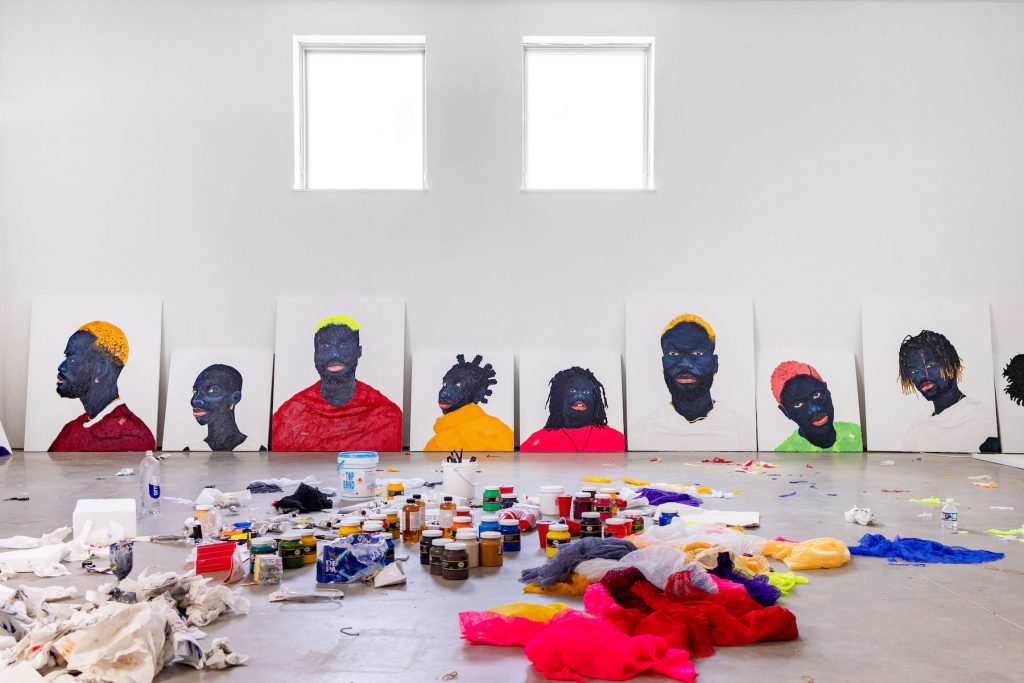
Adjei Tawiah’s studio in Brooklyn, 2023. Courtesy of the artist and the Opera Gallery.
What’s the first thing you do when you walk into your studio (after turning on the lights)?
I meditate. It has become a very important ritual in my process, especially for this show. This particular space, and being so far from my home and my usual artistic community gave me time to dedicate myself to its development. Meditation helps me get in the zone and helps me know what to paint, what colors to use, and what kind of brush strokes to roll out.
What are you working on at the moment?
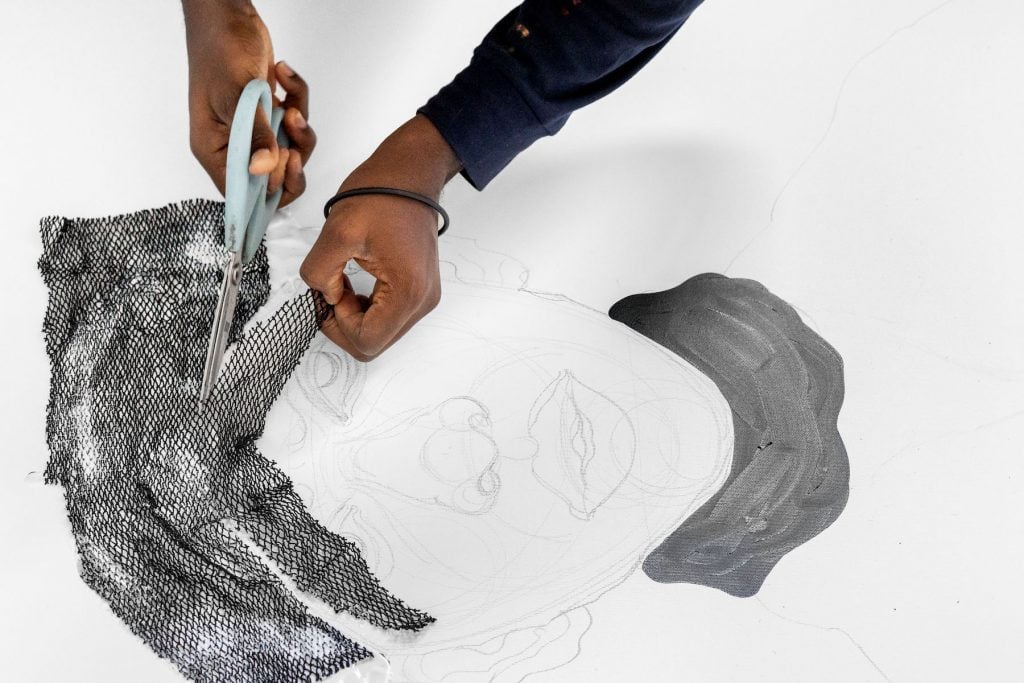 The artist working with kotsa, a nylon terry material popular in Ghana. Courtesy of the artist and the Opera Gallery.
The artist working with kotsa, a nylon terry material popular in Ghana. Courtesy of the artist and the Opera Gallery.
At the moment I am working on a series for my solo exhibition »I miss you“. This is a very important series for several reasons. Firstly because this is my first major solo exhibition in the United States, and secondly because of the themes I explore. “I Miss Us” is about love, loss, grief and healing. It’s a true demonstration of some of the feelings that I’ve harbored deep within me and those that I believe all humans have. Through this show, I want to allow people to enter into a conversation that I think is really vital for society.
What tool or art supply do you most enjoy working with, and why?
Undoubtedly, the local Ghanaian nylon sponge we call kotsa in our local Ga-dangme dialect. The use of kotsa has become my signature and is used as a metaphor for cleansing and renewal. I first had the idea to use it after the death of my mother. Part of the funeral traditions in Ghana among the Ga people includes a process we call kotsa gbamo, which is the corpse bath. It is the final realization that the person can no longer bathe and that others are called upon to do the duty for them. It is one of the rituals performed to ensure that the spirit of the deceased family member can rest rather than wandering the world forever in pain. The Ga word for soul is susumawhich also means spirit or shadow.
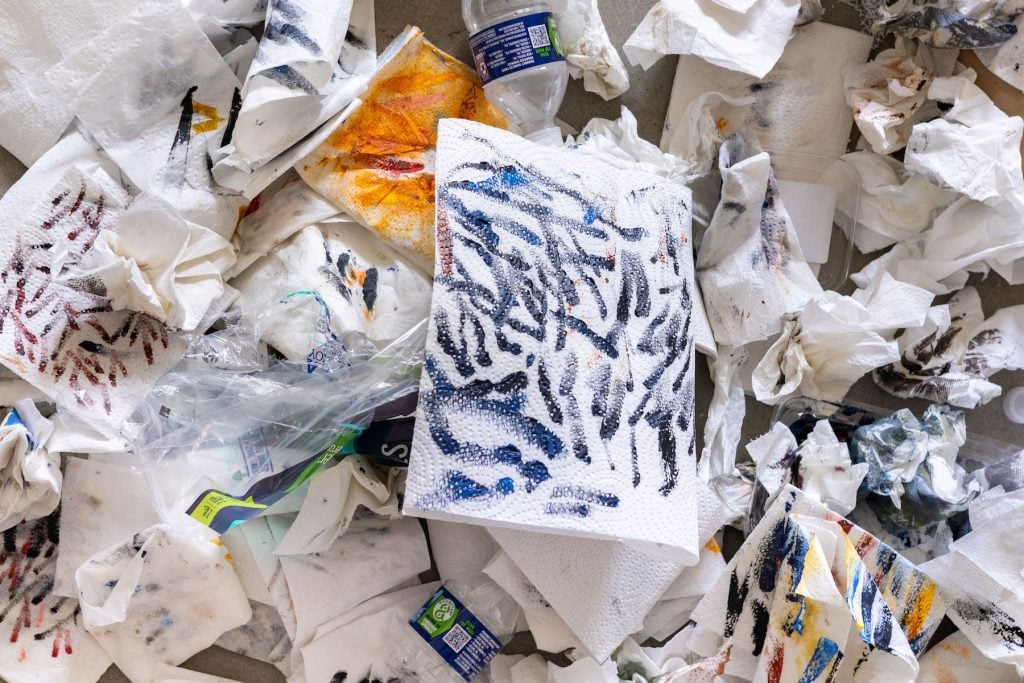
Courtesy of the artist and the Opera Gallery.
What atmosphere do you prefer when you work? Is there something you like to listen to/watch/read/watch in the studio for inspiration or vibe?
Music really inspires me, especially Ga highlife, and especially Wulomei, one of my late mother’s favorite bands. The music really puts me in the right frame of mind for painting, and especially being here in Brooklyn, with this music and the sunlight shining through the windows, I can forget that I’m far from home.
How do you know when a work you are working on clicks? How do you know when it’s a dud?
It’s all in the eyes. Once I’ve painted them, I step back and look at the portrait. If the gaze is straight, it gives me a feeling that I cannot explain. It’s as if we were in communication, but of course, no words are exchanged. If the eyes are off, I know the job is not right.
What was the last museum or gallery exhibit you saw that really stood out to you and why?
I would say “Side by side” And “Terroirwhich were exhibited in Accra in December to launch Amoako Boafo’s new dot.ateliers space, designed by David Adjaye. “Homegrown” was a solo exhibition of works from Boafo’s personal collection, which had never been exhibited before. “Side by Side” was a group exhibition featuring collaborative works between Amoako and his contemporaries, including myself, Kwesi Botchway, Cornelious Anor, and many others. It was organized by Chantel Akworkor Thompson, it’s the first time we’ve worked together. I’m glad she organized “I Miss Us”. The way she interprets my work is so precise and she is brilliant at bridging the gap between Ghana and the rest of the world.
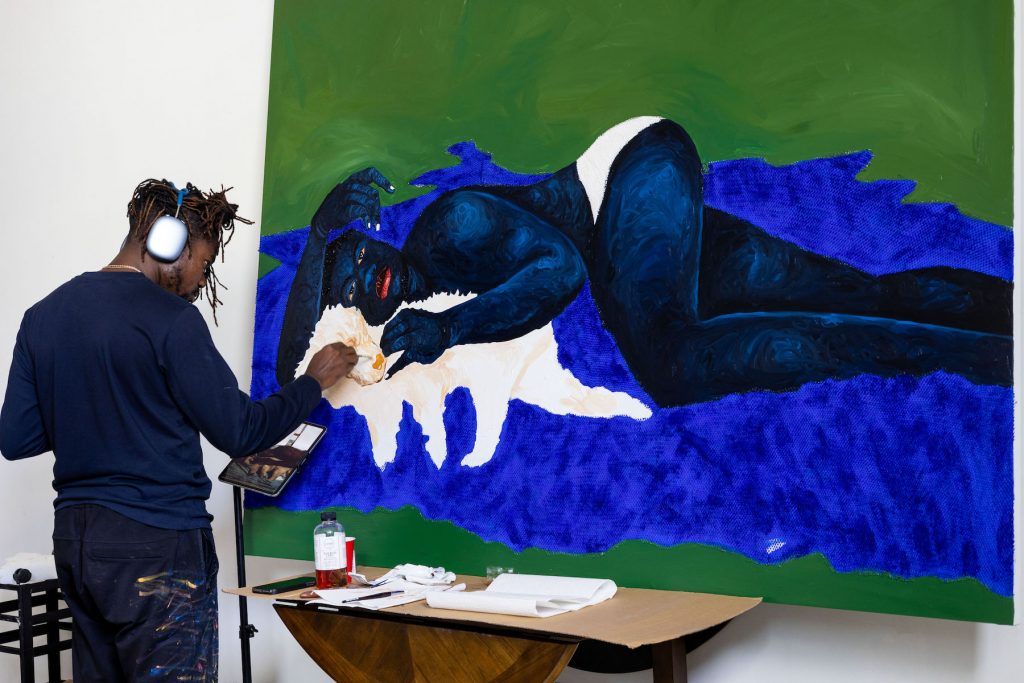
Adjei Tawiah in his Brooklyn studio, 2023. Courtesy of the artist and the Opera Gallery.
What do you eat when you’re hungry in the studio? Where do you get your food?
Waakye, Kenkey, Kontomire stew: these are all local Ghanaian dishes. Fortunately, I discovered an Accra restaurant in Harlem where I buy my Waakye, and Chantel bought me Kenkey from her mother in London, who has been making and selling the dish there for years. Family friends living in New York also cooked and brought me food to the studio. It helps me feel connected to home.
Is there anything in your studio that a visitor might find surprising?
I guess the kotsa, nylon sponge. For non-Ghanaians it’s not something they know, and most people here referred to it as ‘tenderloin’. In Ghana, because it is used for bathing or washing the body, Ghanaians are also surprised to see it in the studio.
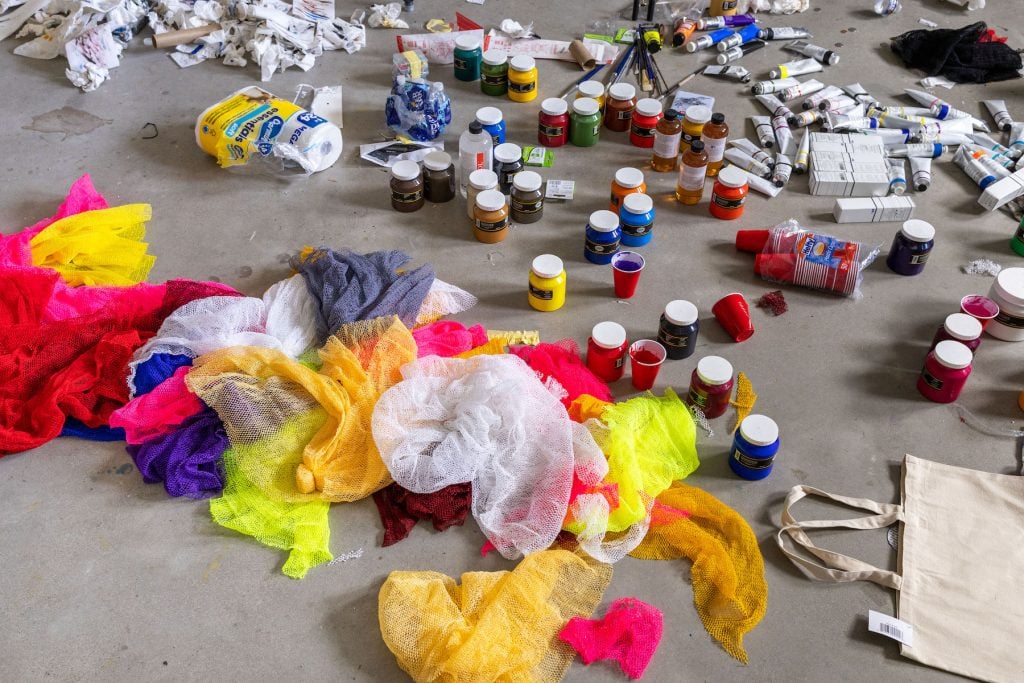
Kotsa, a Ghanaian nylon sponge, in his studio. Courtesy of the artist and the Opera Gallery.
Describe the space in three adjectives.
Meditative, uplifting and rejuvenating.
In silence, I am able to reflect on past experiences. This environment put me in a very good space to create the works of the show. I felt very inspired. With this studio space, I feel like I could almost have a new start in my career.
What do you like to do right after leaving the studio?
When I leave the studio and go home, I like to relax watching comedies. specifically Watch your wordsa British sitcom that debuted in the 1970s still makes me laugh out loud.
Follow Artnet News on Facebook:
Want to stay one step ahead of the art world? Subscribe to our newsletter to receive breaking news, revealing interviews and incisive reviews that move the conversation forward.
